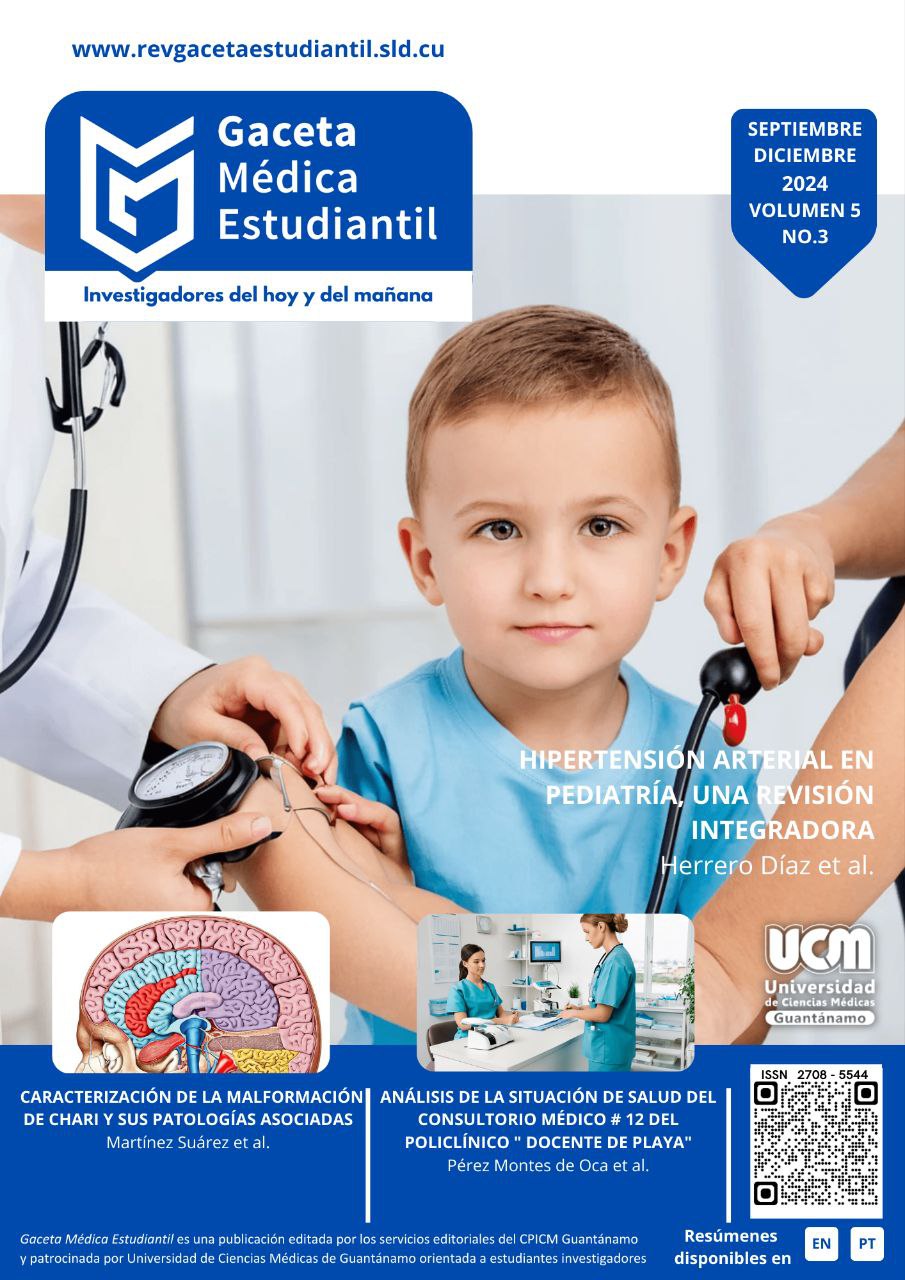Diagnóstico del cáncer mediante biomarcadores circulantes
Palabras clave:
biomarcadores de cáncer, técnicas, diagnóstico, aplicación clínicaResumen
Introdución: según la Organización Mundial de la Salud, el cáncer es una de las principales causas de mortalidad en el mundo, a esta se le atribuyen más de 10 millones de muertes anualmente. Por lo que, gracias al avance de la tecnología, los investigadores buscan desarrollar maneras innovadoras de reducir la morbimortalidad de esta enfermedad a través del desarrollo de múltiples técnicas de detección temprana de esta patología. Objetivo: describir las limitaciones y ventajas, y la aplicación clínica de los biomarcadores circulantes en el diagnóstico del cáncer. Método: en esta investigación es de tipo bibliográfica y descriptiva sobre el Diagnóstico del cáncer mediante biomarcadores circulantes: revisión de técnicas y su aplicabilidad clínica. Por lo que se realizó una consulta inicial en diversas bases de datos de revistas científicas de alto y mediano impacto. Estas bases de datos incluyeron, Scielo, Dialnet Scielo, PubMed, Scopus y ElSavier. Desarrollo: Los biomarcadores predictivos brindan información sobre el efecto de una intervención terapéutica en un resultado y, por lo tanto, ofrecen información valiosa para guiar la toma de decisiones de tratamiento. Los biomarcadores predictivos además proporcionan información sobre el efecto de una intervención terapéutica en el resultado y por tanto ofrece información valiosa para guiar la toma de decisiones en el tratamiento. Consideraciones finales: El estudio de biomarcadores en el diagnóstico del cáncer ha demostrado ser una herramienta prometedora con potencial aplicación clínica.
Descargas
Citas
O'Brien, K., Ried, K., Binjemain, T., & Sali, A. Integrative Approaches to the Treatment of Cancer. Cancers. 2022 [citado 2024 Abr 25]; 14(23), 5933. Disponible en: https://doi.org/10.3390/cancers14235933
Kondo T. Cancer biomarker development and two-dimensional difference gel electrophoresis (2D-DIGE). Biochimica et biophysica acta. Proteins and proteomics, 2019 [citado 2024 Abr 25]; 1867(1), 2–8. Disponible en: https://doi.org/10.1016/j.bbapap.2018.07.002
Zou, J., & Wang, E. Cancer Biomarker Discovery for Precision Medicine: New Progress. Current medicinal chemistry, 2019 [citado 2024 Abr 25]; 26(42), 7655–7671. Dispoible en: https://doi.org/10.2174/0929867325666180718164712
Hristova VA, Chan DW. Cancer biomarker discovery and translation: proteomics and beyond. Expert Rev Proteomics. 2019 [citado 2024 Abr 25]; 16(2):93-103. Disponible en: https://doi:10.1080/14789450.2019.1559062
Bonifácio V. D. B. Ovarian Cancer Biomarkers: Moving Forward in Early Detection. Advances in experimental medicine and biology, 2020 [citado 2024 Abr 25]; 1219, 355–363. Disponible en : https://doi.org/10.1007/978-3-030-34025-4_18
Luo, G., Jin, K., Deng, S., Cheng, H., Fan, Z., Gong, Y., Qian, Y., Huang, Q., Ni, Q., Liu, C., & Yu, X. Roles of CA19-9 in pancreatic cancer: Biomarker, predictor and promoter. Biochimica et biophysica acta. Reviews on cancer, 2021 [citado 2024 Abr 25]; 1875(2), 188409.Disponible en : https://doi.org/10.1016/j.bbcan.2020.188409
Ogata, S., Masuda, T., Ito, S., & Ohtsuki, S. Targeted proteomics for cancer biomarker verification and validation. Cancer biomarkers: section A of Disease markers. 2022 [citado 2024 Abr 25]; 33(4), 427–436.Dispoible en: https://doi.org/10.3233/CBM-210218
National Guideline Alliance (UK). Colorectal cancer. National Institute for Health and Care Excellence; (update): Evidence review B1. London: National Institute for Health and Care Excellence (NICE); 2020 Jan. (NICE Guideline, No. 151.) Disponible en: https://www.ncbi.nlm.nih.gov/books/NBK559933/2020.
Sarhadi, V. K., & Armengol, G. (). Molecular Biomarkers in Cancer. Biomolecules. 2022 [citado 2024 Abr 25]; 12(8). Disponible en: 1021. Disponible en: https://doi.org/10.3390/biom12081021
Ou F-S, Michiels S, Shyr Y, Adjei AA, Oberg AL. Biomarker discovery and validation: Statistical considerations. J Thorac Oncol [Internet]. 2021 [citado el 22 de marzo de 2024];16(4):537–45. Disponible en: https://pubmed.ncbi.nlm.nih.gov/33545385/
Arya S, Estrela P. Recent advances in enhancement strategies for electrochemical ELISA-based immunoassays for cancer biomarker detection. Sensors (Basel) [Internet]. 2018 [citado 2024 Abr 25]; 18(7):2010. Disponible en: https://www.mdpi.com/1424-8220/18/7/2010
Dang K, Zhang W, Jiang S, Lin X, Qian A. Application of lectin microarrays for biomarker discovery. ChemistryOpen [Internet]. 2020 [citado 2024 Abr 25]; 9(3):285–300. Disponible en: http://dx.doi.org/10.1002/open.201900326
Kowalczyk T, Ciborowski M, Kisluk J, Kretowski A, Barbas C. Mass spectrometry based proteomics and metabolomics in personalized oncology. Biochim Biophys Acta Mol Basis Dis [Internet]. 2020 [citado 2024 Abr 25]; 1866(5):165690. Disponible en: http://dx.doi.org/10.1016/j.bbadis.2020.165690
Ivanov YD, Malsagova KA, Popov VP, Pleshakova TO, Kozlov AF, Galiullin RA, et al. Nanoribbon-based electronic detection of a glioma-associated circular miRNA. Biosensors (Basel) [Internet]. 2021 [citado 2024 Abr 25]; 11(7):237. Disponible en: https://www.mdpi.com/2079-6374/11/7/237
Chu Y, Gao Y, Tang W, Qiang L, Han Y, Gao J, et al. Attomolar-level ultrasensitive and multiplex microRNA detection enabled by a nanomaterial locally assembled microfluidic biochip for cancer diagnosis. Anal Chem [Internet]. 2021 [citado 2024 Abr 25]; 93(12):5129–36. Disponible en: http://dx.doi.org/10.1021/acs.analchem.0c04896
Ren X, Foster BM, Ghassemi P, Strobl JS, Kerr BA, Agah M. Entrapment of prostate cancer circulating tumor cells with a sequential size-based microfluidic chip. Anal Chem [Internet]. 2018 [citado 2024 Abr 25]; 90(12):7526–34. Disponible en: http://dx.doi.org/10.1021/acs.analchem.8b01134
Chi Z, Wu Y, Chen L, Yang H, Khan MR, Busquets R, et al. CRISPR-Cas14a-integrated strand displacement amplification for rapid and isothermal detection of cholangiocarcinoma associated circulating microRNAs. Anal Chim Acta [Internet]. 2022 [citado 2024 Abr 25]; 1205(339763):339763. Disponible en: http://dx.doi.org/10.1016/j.aca.2022.339763
Kwong GA, Ghosh S, Gamboa L, Patriotis C, Srivastava S, Bhatia SN. Synthetic biomarkers: a twenty-first century path to early cancer detection. Nat Rev Cancer [Internet]. 2021 [citado el 23 de marzo de 2024]; 21(10):655–68. Disponible en: https://www.nature.com/articles/s41568-021-00389-3
Descargas
Publicado
Cómo citar
Número
Sección
ARK
Licencia
Derechos de autor 2025 Álvaro Pablo Moina-Veloz, Johan Alexander Maldonado-Carrasco , Diana Carolina Chiluiza-Tubon , Virginia Monserrath Ortiz-Vásquez

Esta obra está bajo una licencia internacional Creative Commons Atribución-NoComercial 4.0.
La revista Gaceta Médica Estudiantil proporciona un Acceso Abierto inmediato a su contenido. Es publicada bajo una licencia Creative Commons Reconocimiento-NoComercial 4.0 Internacional (CC BY-NC) que permite compartir (copiar y redistribuir el material en cualquier medio o formato) y adaptar (remezclar, transformar y crear a partir del material), bajo las condiciones de reconocer la autoría y no hacer uso comercial de los materiales.












